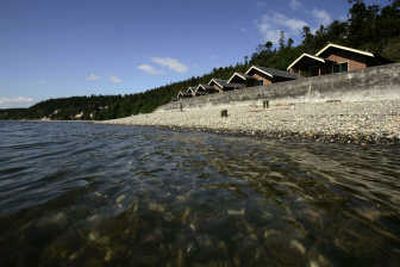New park booked for summer

CAMANO ISLAND, Wash. – A week before its June 21 opening, Washington’s first new state park in more than a decade is already a hit.
Cama Beach State Park on the southwest shore of Camano Island was featured in the June issue of Sunset, prompting 400 reservations the day after the magazine hit newsstands. By Friday, the park was completely booked through Labor Day and every weekend into October.
“It’s a jewel,” said state Sen. Mary Margaret Haugen, D-Camano Island, who grew up on the island and helped lead the state’s efforts to acquire and restore the former 1930s-era fishing resort.
But not everyone is celebrating the $35 million park’s opening.
The Tulalip Tribes initially agreed with plans to turn the site into a park, but withdrew support when archaeologists in 2005 uncovered human remains and other Native American artifacts that date back 1,600 years. The Tulalips unsuccessfully sued the state to stop development, arguing that the site of a possible ancient village and large shell midden should not be open to the public.
As a result of the Tulalip Tribes’ opposition, plans for an interpretive center at the park are on hold pending their participation. The center would tell the stories of Coast Salish Indians, as well as describing turn-of-the-century logging operations at the site and its years as a family resort.
“We’re committed to working together,” said Rex Derr, director of the state parks department. “We’ve told them, ‘We’ll go forward when you’re ready.’ “
Tulalip spokesman George White said this week that the tribes would not comment on the opening of the state park.
Parks officials say the state has been sensitive to Cama Beach’s Native American history. A planned small retreat center with a dining hall and lodging, scheduled to open in 2010, was relocated to a hillside to protect the area where human remains were found on the north side of the property.
Parks workers also raised up the park’s 24 waterfront cabins, brought in 5,000 yards of fill dirt and laid utilities in shallow, hand-dug trenches while an archaeologist and observers from several tribes looked on.
“We did everything we could to have as little intrusion into the midden as possible,” Park ranger Jeff Wheeler said. “It’s important to protect all the histories that are here.”
A representative of the Upper Skagit Tribe, which gathers shellfish along Cama Beach under treaty rights, says their rights were sometimes difficult to exercise when the area was privately owned.
“We’re pleased to see the park open,” said Scott Schuyler, cultural-policy representative for the tribe. “The site is more accessible to us, as well as to the public.”
The state acquired the fishing resort and surrounding 400-plus acres in 1994 from the daughters of the original owners of the Cama Beach Resort, which operated from 1934-89. Sisters Karen Hamalainen and Sandra Worthington gave the state 60 percent of the land and sold the remaining west-facing hillside for $6.7 million, for a total property value of $16.4 million.
The construction, renovation and other improvements so far cost $18.8 million. Wheeler said an archaeologist hired by the family found evidence of an ancient shell midden in 1995, but the site had been disturbed over the years and wasn’t believed to be culturally significant, he said.
The Tulalips, along with the Swinomish, Upper Skagit and Stillaguamish tribes, agreed to development plans for the new state park in 2002, but more intensive archaeological analyses between 2002-05 uncovered fragmentary remains of four Native Americans, as well as tools, beads and other artifacts.
The Tulalips said that according to historical accounts, as many as 22 Indian remains were unearthed when the resort was first built. Thurston County Superior Court judge in 2006 denied the tribes’ request to stop work at the park pending further archaeological analysis. The parks system voluntarily put the interpretive center on hold.
The remains were found in an area on the north side of the park property, which will not be developed.
Last year, the tribes nominated the ancient Indian village at Cama Beach for placement on the National Register of Historic Places. The fishing resort was already listed. Tulalip Tribal Chairman Mel Sheldon said at the time that the designation would give more protection to the Coast Salish midden and village. That request was denied because it was determined the site’s past was not adequately documented.
The opening of the park represents a remarkable turnaround for a state parks system that in 1998 proposed closing 42 parks because of severe budget deficits and an estimated $350 million maintenance backlog.
The public outcry that followed prompted an increase in state funding, but also a mandate from the Legislature for the state’s parks to become more entrepreneurial and pay more of their own way.
One idea to raise money for the system a $5 day-use fee instituted in 2003 proved wildly unpopular. Although it raised about $11.5 million over three years for operations and maintenance, many park users decried the charge. Attendance dropped about 7 million annually, or 16 percent, before the state repealed the fee in 2006.
Rangers now develop business plans for parks and are finding new ways to generate revenue, from park souvenirs to lodging that ranges from yurts to historic Victorian homes. Rangers more actively market their properties as sites for weddings, family reunions and other special events.